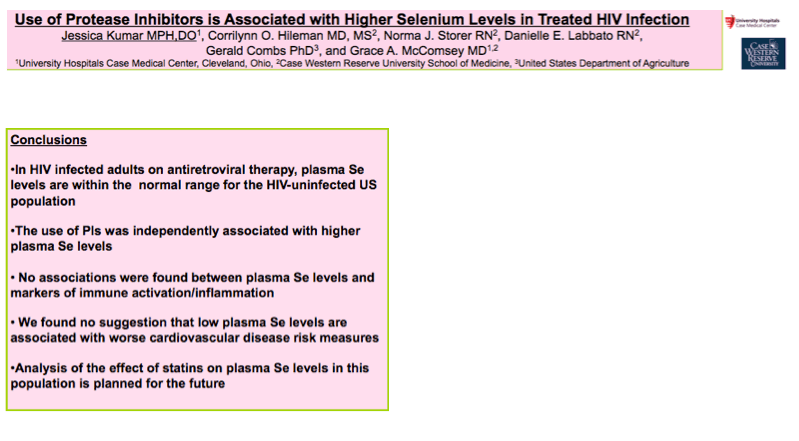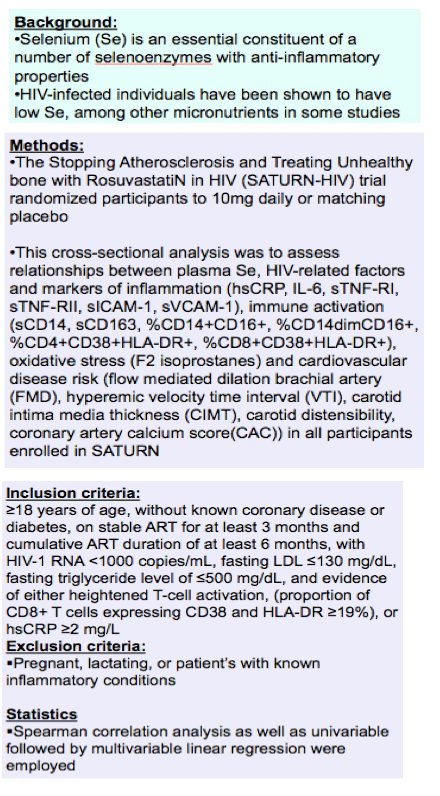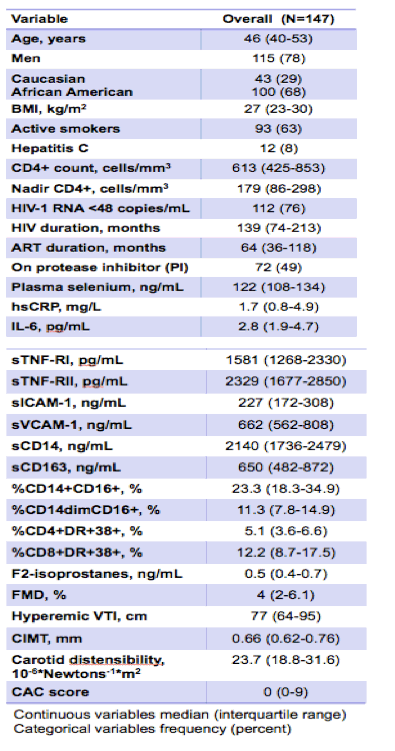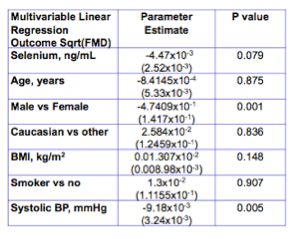 |
 |
 |
| |
Current PI, White Race, Lower BMI Linked to Higher Selenium in HIV Group
|
| |
| |
IDWeek 2014, October 8-12, 2014, Philadelphia
Mark Mascolini
Current protease inhibitor (PI) use, Caucasian race, and lower body mass index (BMI) were linked to higher levels of selenium, a cofactor for several enzymes that have antiinflammatory properties [1]. But selenium was not directly associated with markers of inflammation or immune activation or with cardiovascular disease indicators in this 147-person study at Cleveland's Case Western Reserve University.
Besides acting as a cofactor for antiinflammatory enzymes, selenium can influence immune activation, inflammation, and cardiovascular function. Some research shows that HIV-positive people have below-normal selenium levels [2]. To get a better understanding of selenium levels and factors that may influence those levels, the Case Western team analyzed selenium in HIV-positive adults randomized to rosuvastatin or placebo in the SATURN-HIV trial.
This cross-sectional analysis focused on relationships between selenium, demographics, HIV-related factors, cardiovascular risk, and markers of inflammation, immune activation, and oxidative stress. Study participants were 18 or older and had no known coronary disease or diabetes. All participants had taken a stable antiretroviral regimen for at least 3 months and had taken antiretrovirals for at least 6 months. All had a viral load below 1000 copies, fasting low-density lipoprotein cholesterol at or below 130 mg/dL, and fasting triglycerides at or below 500 mg/dL. Everyone had evidence of heightened T-cell activation or high-sensitivity C-reactive protein (hsCRP, an inflammation marker) at or above 2 mg/L. The study excluded pregnant or lactating women and those with an inflammatory condition.
The study included 147 people with a median age of 46. Three quarters (78%) were men, 68% African American, and 29% Caucasian. While 63% were active smokers, 8% were HCV positive. Median CD4 count stood at 613. Participants had been infected with HIV for a median of 139 months and had taken antiretroviral therapy (ART) for a median of 64 months. Seventy-two people (49%) were taking a PI. Median selenium level stood at 122 ng/mL.
Multivariate analysis identified three factors associated with higher selenium levels at the following parameter estimates (and standard errors):
-- Caucasian versus other: 1.0805 x 10(-1) (3.156 x 10[-2]), P < 0.001
-- Currently taking a PI: 6.17 x 10(-2) (2.86 x 10[-2]), P = 0.033
-- Lower BMI: -5.51 x 10(-3) (2.21 x 10[-3]), P = 0.014
Variables not associated with selenium levels in this multivariate analysis were gender, glomerular filtration rate (GFR-CKD EPI), CD4 count, Log-CD8+ CD38+/HLA-DR+, Log-sVCAM-1, and Log-hsCRP.
No markers of inflammation or monocyte or lymphocyte activation were associated with selenium levels. Coronary artery calcium score and carotid artery intima-media thickness were not associated with selenium levels. But, against expectation, flow-mediated dilation of the brachial artery was inversely correlated with selenium: rho = -0.222; P = 0.007; for men rho = -0.17, P = 0.07; for women rho = 0.09, P = 0.62 for women. But this association did not remain statistically significant after adjustment for standard cardiovascular risk factors.
The Case Western team concluded that selenium levels in HIV-positive people taking antiretrovirals are in the normal range of the HIV-negative US population. Only current PI therapy, Caucasian race, and lower BMI were associated with selenium levels; markers of inflammation or immune activation were not. Selenium levels were not associated with measures of cardiovascular disease.
In their ongoing study, the investigators will analyze the effect of statins on selenium levels in these patients.
Other recent research found higher selenium levels with longer ART in a cross-sectional study of Brazilian men [3]; no correlation between selenium levels and ART outcomes in Thai children without severe immune deficiency [4]; and reduced risk of diarrhea with selenium supplementation in a longitudinal study of HIV-positive Tanzanian women [5]. Researchers at the University of Alabama at Birmingham recently reviewed the role of selenium in HIV infection [2].
References
1. Kumar J, Hileman C, Storere NJ, et al. Use of protease inhibitors is associated with higher selenium levels in treated HIV infection. IDWeek 2014. October 8-12, 2014, Philadelphia. Abstract 1573.
2. Stone CA, Kawai K, Kupka R, Fawzi WW. Role of selenium in HIV infection. Nutr Rev. 2010;68:671-681. http://www.ncbi.nlm.nih.gov/pmc/articles/PMC3066516/
3. de Menezes Barbosa EG, Junior FB, Machado AA, Navarro AM. A longer time of exposure to antiretroviral therapy improves selenium levels. Clin Nutr. 2014;pii S0261-5614(14)00087-9. http://www.ncbi.nlm.nih.gov/pubmed/24746975
4. Bunupuradah T, Ubolyam S, Hansudewechakul R, et al. Correlation of selenium and zinc levels to antiretroviral treatment outcomes in Thai HIV-infected children without severe HIV symptoms. Eur J Clin Nutr. 2012;66:900-905. http://www.ncbi.nlm.nih.gov/pubmed/22713768
5. Kupka R, Mugusi F, Aboud S, Hertzmark E, Spiegelman D, Fawzi WW. Effect of selenium supplements on hemoglobin concentration and morbidity among HIV-1-infected Tanzanian women. Clin Infect Dis. 2009;48:1475-1478. http://cid.oxfordjournals.org/content/48/10/1475.long





|
| |
|
 |
 |
|
|